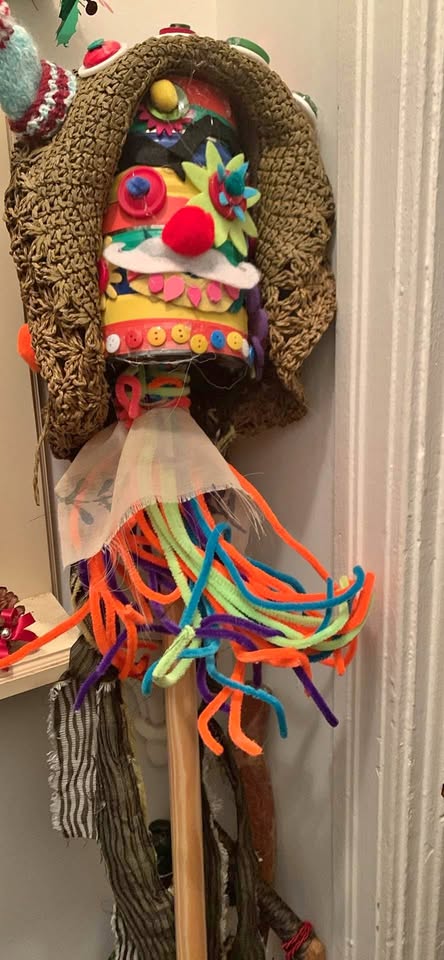The Newfoundland Ugly Stick is a distinct and whimsical folk percussion instrument, deeply rooted in the cultural fabric of Newfoundland and Labrador, Canada. This unique instrument encapsulates the spirit of improvisation and resourcefulness, characteristic of Newfoundland’s musical tradition. Its quirky name, “Ugly Stick,” reflects its typically rustic and makeshift appearance, which belies the joyous and vibrant sounds it produces.
Constructed primarily from commonplace materials, the Ugly Stick consists of a long wooden stick, at the base of which is affixed a rubber boot or similarly flexible object. This boot acts as a resonator, producing a distinctive bass sound when struck against the ground. Along the length of the stick, various noise-making objects are attached, such as bottle caps, tin cans, and small bells.
These objects jingle and rattle, adding a rich layer of percussive sounds. The stick is typically played with a smaller stick, sometimes a spoon or a bone, which the player uses to rhythmically strike the main stick, creating a combination of melodic clatters and rhythmic thuds.
The Newfoundland Ugly Stick’s Important Role
What sets the Ugly Stick apart is not just its sound, but also its role as a symbol of Newfoundland’s folk culture. It’s often played in informal settings like kitchen parties, a traditional Newfoundland gathering where music, dance, and storytelling are central. These instruments are not just tools for music-making; they are embodiments of a communal spirit, bringing together people of all ages in celebration and song.
The Ugly Stick reflects the creativity and adaptability of the Newfoundland people. No two Ugly Sticks are exactly alike; each one is a unique creation, decorated and constructed according to the individual maker’s preference and available materials. This personalization makes each Ugly Stick not only a musical instrument but also a piece of folk art.
The Newfoundland Ugly Stick Today
In modern times, the Ugly Stick continues to be a significant part of Newfoundland’s cultural heritage. It is used in educational settings to teach children about traditional music and is a staple in folk festivals and cultural events. The instrument has gained recognition beyond Newfoundland, captivating audiences worldwide with its distinctive sound and its story as a testament to the enduring charm and vitality of folk traditions.
It’s essentially a homemade percussion instrument, typically crafted from household and tool shed items: a mop handle with bottle caps, tin cans, small bells, and other noise-makers attached. It’s played by striking it against the floor and hitting the attached objects with a stick or a spoon. The ugly stick adds a distinctive rhythmic background to many traditional Newfoundland songs, though it’s not always explicitly mentioned in recordings or performances.
Here is a list of Newfoundland songs and types of music where an ugly stick might typically be used:
“I’se The B’y” – A lively traditional Newfoundland folk song that often features robust instrumentation, including sometimes the ugly stick.
“The Kelligrews Soiree” – A song that tells a story of a local party or gathering, where the ugly stick would fit right in with the festive atmosphere.
“Lukey’s Boat” – A well-known Newfoundland folk song that could be accompanied by the rhythm of the ugly stick.
“Heave Away” (The Fables) – A popular Newfoundland tune often performed with a full range of folk instruments, potentially including the ugly stick.
Jigs and Reels – The ugly stick is commonly used in traditional Newfoundland jigs and reels, providing a rhythmic backbone to the music.
“Mussels in the Corner” – A classic Newfoundland folk song that could easily incorporate the unique sound of the ugly stick.
“The Night Paddy Murphy Died” (Great Big Sea) – A song by a well-known Newfoundland band that often includes a variety of traditional instruments.
“Saltwater Joys” (Buddy Wasisname and the Other Fellers) – This band is known for its use of traditional Newfoundland instruments, and an ugly stick could be used in live performances of their songs.
Remember, while these songs lend themselves well to the inclusion of an ugly stick, traditional Newfoundland music is very much an oral tradition, and the use of instruments can vary greatly from one performance to another.
The ugly stick, while not always a prominent feature in recorded versions, is a staple in live performances, especially in more informal settings like kitchen parties and local gatherings.




